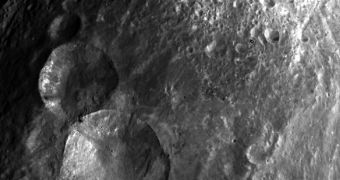Mission controllers for the Dawn spacecraft were surprised to see an unexpected formation on the surface of the massive asteroid Vesta, in the latest batch of images the orbiter sent back to Earth.
The photos show a region of the large space rock that is riddled with craters, of which several were formed in a strange pattern, resembling a cosmic snowman. Impact marks here are somewhat aligned, and apparently ordered by size.
In the lower-central part of the image, experts identified the largest impact crater, with a diameter at least 50 kilometers. Moving towards the northwest, three more craters can be seen. All of them are progressively smaller than the ones before.
This is the first surprising discovery made on Vesta, since the NASA Dawn mission arrived there on the evening of July 15. The prove began conducting limited scientific investigations as soon as it arrived, as it awaits for all of its instruments to be brought online.
The craters in this cluster are “very interesting to us because they appear to be shallow,” explains Dawn framing camera team member Holger Sierks, who is based at the Max Planck Society, in Germany. He made the announcement during a press conference held on Monday, August 1.
Experts say that the view which was released to the press is taken from an altitude of about 3,200 miles (5,200 kilometers), which should give viewers some context on just how large these poke marks are.
Dawn will study the asteroid until August 2012. During this time, it will seek to understand as much as possible about the chemical and physical composition of the space rock. Experts believe that Vesta is in fact a protoplanet.
What this means is that it had the potential to turn into a fully-fledged rocky planet, in the early days of the solar system. It could have developed to look like Mercury, Venus, Mars and Earth, but for some reason it didn't, Space reports.
Astronomers are very interested in learning why this happened. The data could provide additional insight into how planets form, and may also shed light on some mysteries related to how the solar system looked like when it was very young.
Once the NASA orbiter finishes its 1-year stay at Vesta, it will depart the asteroid, and head for the dwarf planet Ceres, which it will also study for an extended period of time. Both celestial bodies are located between the orbits of Mars and Jupiter, in the Inner Asteroid Belt.

 14 DAY TRIAL //
14 DAY TRIAL //